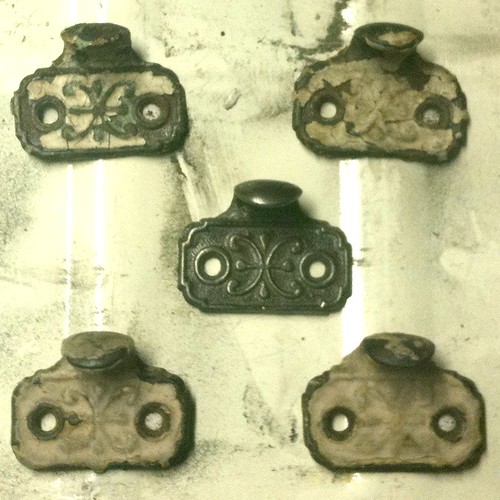One of the tasks we've been faced with throughout our renovation involves the discovery and restoration of period authentic hardware. We're replacing hinges, rim locks, door knobs, and any number of iron or steel items that have removed from the house by previous owners and renters. Typically, our search for these items leads us to various salvage yards and junk shops, and when the items are found they are often covered in rust and/or paint and in need of a little TLC.
Initially I was at a bit of a loss as to how we would remove the buildup of paint and rust that covered the majority of our salvage yard finds. I knew we could strip the paint with a paint stripper soak, or even use a croc pot (it does actually work and is very safe), but once the paint is off, you are left with a residue of paint and liquid that tends to coat the surface. You could use steel wool and a lot of elbow grease, but that is tough to get into the crevices and details. I went this route for a little while, but then, one day many years ago, I was talking to a home builder that puts salvaged items into new homes to get that period look. He said, "just hit it with the wire wheel."
Those magic words have been the best possible solution time and time again. Throughout our experience, there is no better way to clean up your hardware and get it ready for the house than through the use of a wire wheel on a bench top grinder.
After my conversation with the home builder, I went out and bought a small Delta bench grinder. I knew I would have a need for this tool beyond paint stripping, and I have previously used this same Delta grinder, so I wasn't worried if the wire wheel didn't work out. I also picked up a 6" brass wire wheel attachment that would fit my grinder (this is the real workhorse of the assembly).
This grinder is a variable speed bench grinder with two grinding wheels. I usually leave the stone wheel on one side while the wire wheel sits on the other. It is small and portable, but is quite stable and heavy and has plenty of power for all of the jobs I've used it for. This includes hardware stripping, tool cleanup, chisel sharpening, and even to make a few grinding cuts to remove a tiny bit of material when necessary.
To attach the wire wheel, you will need to remove the grinding guard off of one of the sides of the machine. Also, it is EXTREMELY IMPORTANT to wear safety glasses, gloves, closed toe shoes, a helmet, knight's armor, and every level of protective skateboard gear you have while working with the grinder. Seriously, be safety conscious, I've had stuff fly out of my hand and hit me in the legs and feet. If I wasn't wearing shoes and long pants, I would have been hurting quite a bit. And safety glasses are #1 when working on the bench grinder with wire wheel.
The one drawback I've found with this tool is how it likes to "walk" when I turn it on. Though the bench grinder likes to be bolted to your workbench surface, this isn't feasible for our house, we just don't have the room. As a result, the grinder vibrates a lot more than usual, and any attempt at putting a light bulb into the attacked socket almost immediately shakes the bulb until it burns out. This is a minor drawback, but I just don't use the light feature.
Overall, this setup has worked wonders for our hardware restoration needs. Just look at what this tool was able to do to our window sash lifts.
It is really amazing to see an old piece of hardware come back to life with just a little bit of effort.
Do you have a favorite method for cleaning up and restoring hardware parts? Please share your tried and true methods that you always use to strip paint from non wood surfaces? Let me know, I'm looking to work on another "Trash to Treasure" find of Wendy's.

![]()
![]()